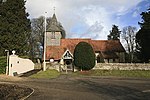Chattis Hill
Hamlets in HampshireHampshire geography stubsTest Valley

Chattis Hill is a hamlet in the Test Valley district of Hampshire, England. The village lies approximately 2 miles (3.3 km) west from Stockbridge, which both lie on the A30 road. At the 2011 Census the Post Office indicates that the population of the hamlet was included in the civil parish of Broughton.
Excerpt from the Wikipedia article Chattis Hill (License: CC BY-SA 3.0, Authors, Images).Chattis Hill
Broughton Road, Test Valley Broughton
Geographical coordinates (GPS) Address Nearby Places Show on map
Geographical coordinates (GPS)
| Latitude | Longitude |
|---|---|
| N 51.1154 ° | E -1.53468 ° |
Address
Broughton Road
Broughton Road
SO20 6JT Test Valley, Broughton
England, United Kingdom
Open on Google Maps









